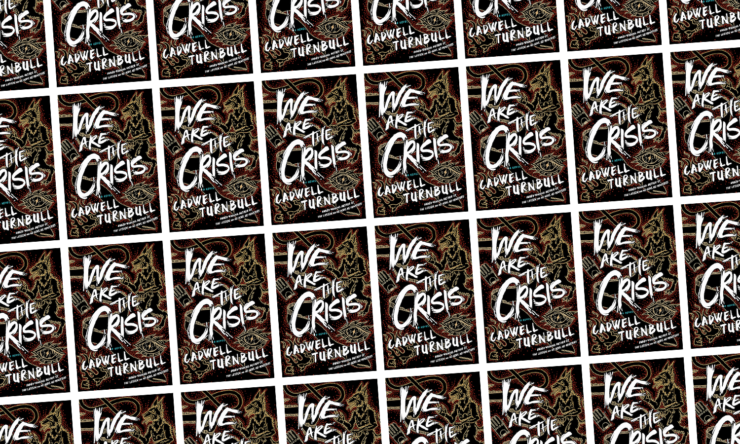Supernatural fiction abounds with tales of vampires, werewolves, and other uncanny beings living among us, from the paranormally-charged small towns of Charlaine Harris’s fiction to the visceral political thrills of Benjamin Percy’s Red Moon. Cadwell Turnbull’s Convergence Saga—the first book of which was 2021’s No Gods, No Monsters—falls somewhat in this category. It is, by and large, set in a world similar to our own, albeit one where the bulk of the humans residing there have recently become aware that some of their friends and neighbors possess uncanny abilities. Werewolves feature prominently in the series, though they’re far from the only supernatural beings to do so.
Turnbull’s ambitions have taken this series in unexpected directions, something the series’s second volume, We Are the Crisis, makes clear. There’s a political dimension to these novels—something that the title No Gods, No Monsters probably made clear. Turnbull also incorporates differing political scales in the proceedings: One subplot involves political intrigue in the U.S. Virgin Islands, while another uses the existence of monsters and the backlash they face as a kind of metaphor for historically marginalized groups in society. (As someone who grew up reading Chris Claremont’s run on Uncanny X-Men, it’s a construction I know well.)
Turnbull doesn’t stop there, either. The first chapter of the book opens with a statement of the location, noting that the characters covered by that chapter are near Boston. Eight chapters later, things get a bit more cosmic when Turnbull reveals that this chapter is set on “Earth 0539.” In other words, this isn’t just a politically-charged take on shapeshifters living among us; it’s also a tale of the multiverse. Well, kind of.
Buy the Book


We Are the Crisis
Full disclosure: This is the second book in a saga (which is also, as per the author, a trilogy), and some of the appeal here comes from Turnbull taking the story in a very unexpected direction. If you’ll pardon a potentially overcomplicated comparison: It’s like watching a magician juggle a series of burning torches, only for the magician to reveal that he’s also going to saw his assistant in half while keeping the torches aloft. You’re not necessarily sure how he’s going to pull it off, but the bravado involved has an energy all its own.
(Some spoilers for We Are the Crisis follow.)
The novel opens with three werewolves on the move: Ridley Gibson, Laina Calvary, and Rebecca Vázquez. And while there are parts of their journey outside of Boston that are tinged with the uncanny—including their ability to “ride their wolves until the morning” to do without sleep—there are also more quotidian elements to their trip. This is, in fact, a road trip that includes a singalong to the music of Carly Rae Jepsen. They make their way north of the city, investigating the disappearance of another werewolf, and realize that they’re being followed by a mysterious and potentially sinister woman.
Things get more surreal, and more violent, from there. But one of the most compelling elements of Turnbull’s style here is the sense of detachment that he brings to the narration:
Rebecca, unlike Ridley and Laina, looks perfectly at ease being naked in a meadow with a dead vampire and a strange wolf that only minutes ago was trying to kill them.
Also on the agenda for the trio is everything from the mystery of the aforementioned strange wolf, their work to defend themselves against an extremist group looking to commit acts of violence against monsters, and the presence of powerful forces that suggest an even larger struggle working behind the scenes.
And then Turnbull takes us from here to the life of a woman named Marjorie Cameron, a resident of a parallel Earth in this novel’s cosmology—and, it’s worth mentioning, a real occultist who was married to rocket scientist Jack Parsons and had ties to both L. Ron Hubbard and Aleister Crowley. And from there, Turnbull takes us to a different earth in a section narrated in the first person and whose narrator has the ability to visit other places and times, where he encounters alternate versions of the people he knows.
There is a lot going on here, from a sense of social upheaval in one world as humanity and monsters ponder whether or not they can coexist to the subplots about mid-20th century occultism and visits to parallel universes. It’s a lot to take in, and this very much feels like a fraction of a larger whole rather than a self-contained volume. Then again, Turnbull has written of the first volume in this series that “[t]he protagonist is the community,” and that seems to be the case here as well. So far, Turnbull’s plotting keeps the pace moving, his characters are interesting, and his ambition is vast. It’s a good combination of qualities.
We Are the Crisis is published by Blackstone Publishing.
Tobias Carroll is the managing editor of Vol.1 Brooklyn. He is the author of the short story collection Transitory (Civil Coping Mechanisms) and the novel Reel (Rare Bird Books).










